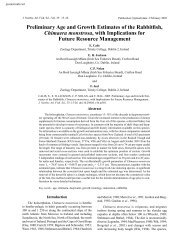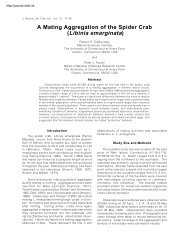ANGUILLIFORMES Leptocephalus Larvae Diagrammatic Family ...
ANGUILLIFORMES Leptocephalus Larvae Diagrammatic Family ...
ANGUILLIFORMES Leptocephalus Larvae Diagrammatic Family ...
Create successful ePaper yourself
Turn your PDF publications into a flip-book with our unique Google optimized e-Paper software.
46<br />
<strong>ANGUILLIFORMES</strong><br />
General features<br />
J. Northw. Atl. Fish. Sci., Vol. 4,1983<br />
<strong>Leptocephalus</strong> <strong>Larvae</strong><br />
(Castle 1969; Smith 1979)<br />
- Body elongate, compressed, transparent, with small head.<br />
Myomeres visible over lateral surface.<br />
- Gut along ventral margin of body; simple tube or with swellings or convolutions.<br />
- Kidney elongate; lying along top of gut.<br />
- Vertical blood vessels extend between gut and aorta at the body midline.<br />
No pelvic fins.<br />
Dorsal and anal fins short to (usually) long, always confluent with caudal.<br />
Pectoral fin rays late forming but fins may be reduced or absent.<br />
Caudal rays total 5-11, fins may be absent in Ophichthidae.<br />
Larval teeth fang-like (lost at metamorphosis).<br />
Important identifying features<br />
- Shape of body, head, snout, and tail tip.<br />
Relative length and form of gut.<br />
Number of myomeres, preanal, predorsal and total.<br />
Position of vertical blood vessels.<br />
Location and extent of pigment spots.<br />
- Size and position of nasal organ.<br />
Maximum size before metamorphosis.<br />
Note: <strong>Leptocephalus</strong> larvae are also found in the orders Elopiformes and Notacanthiformes.<br />
Elopiform larvae have large, forked caudal fins (see Elopidae, Albulidae).<br />
Notacanthiform larvae replace the caudal fin with a long filament and have a short,<br />
anterior dorsal fin.<br />
Loop with many<br />
melanophores,<br />
gut 50-67% SL<br />
SACCOPHARYNGOIDEI<br />
<strong>Diagrammatic</strong> <strong>Family</strong> Key to Eel Leptocephali<br />
(After Smith 1979)<br />
1 loop<br />
at posterior<br />
end of gut<br />
Loop with single or<br />
few melanophores,<br />
gut 67-75% SL<br />
MORINGUIDAE<br />
Gut with loops<br />
or swellings<br />
2 loops, gut
Pectoral fin<br />
well developed<br />
gut >50% SL<br />
ANGUILLIDAE<br />
Pectoral fin reduced<br />
or absent, rounded<br />
tail, blunt snout<br />
MURAENIDAE (part)<br />
Lateral pigment<br />
sometimes, last<br />
blood vessel at<br />
myomeres 30-37<br />
SERRIVOMERIDAE<br />
Body moderately<br />
deep, head short<br />
XENOCONGR IDAE<br />
No pigment except in iris,<br />
or very few lateral spots<br />
anteriorly<br />
FAHAY: Guide to Ichthyoplankton Identification 47<br />
<strong>Leptocephalus</strong> <strong>Larvae</strong> <strong>ANGUILLIFORMES</strong><br />
Simple tubular gut<br />
Pectoral fin<br />
greatly reduced,<br />
gut
52<br />
<strong>ANGUILLIFORMES</strong><br />
Muraenidae (Anarchias)<br />
J. Northw. Atl. Fish. Sci., Vol. 4, 1983<br />
<strong>Family</strong> Characters<br />
Leptocephali with Simple Tubular Guts (cont'd)<br />
- Gut length
Heterenchelyidae<br />
FAHAY Guide to Ichthyoplankton Identification 55<br />
<strong>Family</strong> Characters <strong>ANGUILLIFORMES</strong><br />
Leptocephali with Simple Tubular Guts (cont'd)<br />
Gut length 80-90% SL.<br />
Body moderately elongate.<br />
Tail moderately blunt.<br />
Head short and deep, snout becomes blunt with growth.<br />
Maximum leptocephalus size 60-70 mm.<br />
Myomeres about 108-109.<br />
Dorsal fin origin at about midbody.<br />
Gut pigment present.<br />
Single row of lateral spots.<br />
Larva of the single western Atlantic species, Pythonichthys sanguineus, undescribed.<br />
Nettastomatidae (Facciolella)<br />
PythonJchthys microphthalmus<br />
(Blache 1977)<br />
Gut simple and thick.<br />
- Gut length
56<br />
<strong>ANGUILLIFORMES</strong><br />
Nemichthyidae<br />
J. Northw. Atl. Fish. Sci., Vol. 4, 1983<br />
<strong>Family</strong> Characters<br />
Leptocephali with Simple Tubular Guts (cont'd)<br />
- Gut length about 90% SL.<br />
- Body elongate.<br />
- Tail moderate to sharp.<br />
- Snout sharp, profile concave.<br />
Maximum leptocephalus size 300-400 mm.<br />
Myomeres 170-300+.<br />
- Dorsal fin origin anterior to vent.<br />
- Gut pigment on bottom of gut anteriorly, top of gut posteriorly.<br />
- Lateral pigment none or few widely-spaced spots below midline.<br />
- Spots along top of spinal cord.<br />
- Small nasal organ close to eye.<br />
Muraenesocidae<br />
- Closely related to Congridae.<br />
- <strong>Larvae</strong> similar to congrid larvae.<br />
Nemichthys scolopaceus<br />
(Smith 1979)<br />
Paraxenomystax sp.<br />
(Fahay 1976)
58<br />
ANGUILLIDAE<br />
J. Northw. Atl. Fish. Sci., Vol. 4,1983<br />
Anguilla rostrata (Lesueur)<br />
Spawning: January-July, presumably in the Sargasso Sea or<br />
farther south.<br />
Eggs Undescribed.<br />
Meristic features<br />
Myomeres: 102-111<br />
<strong>Larvae</strong> <strong>Leptocephalus</strong>.<br />
Gut straight and long (about 70-75% TL), shortens at metamorphosis.<br />
Pectoral fin rays form late; pelvic fin absent.<br />
- Maximum size before metamorphosis about 70 mm.<br />
Lower jaw protrudes in glass eel and elver.<br />
- Elvers arrive in Mid-Atlantic Bight estuaries during the spring.<br />
- Pigmentation: none, except in eye, until glass eel stage.<br />
Note: (1) Anguilla anguilla (Linnaeus), the European eel, is similar and may be collected<br />
in the western North Atlantic; myomeres 111-119 (Vladykov and March 1975).<br />
(2) The only other unpigmented leptocephalus reported from the western North<br />
Atlantic is Anarchias yoshiae (Fig. F opposite), a muraenid with 107-114<br />
myomeres, the posterior nostril near upper margin of eye, pectoral fin totally<br />
lacking, gut about 50% TL, and a blunt tail. Leptocephali may have a few<br />
internal pigment spots near the brain (Smith 1979), and inconspicuous spots<br />
along the ventral margin of the spinal cord.<br />
Fig. - A-B, Vladykov 1955; C-E, Schmidt 1916; F, Eldred 1968b (A-E redrawn).<br />
Ref. - Eldred 1968c.
60<br />
OPHICHTHIDAE<br />
J. Northw. Atl. Fish. Sci., Vol. 4, 1983<br />
Ophichthus cruentifer (Goode and Bean)<br />
Spawning: This is the only ophichthid eel which spawns in the<br />
Mid-Atlantic Bight, in summer near edge of continental<br />
shelf.<br />
Eggs Pelagic, large, no pigmentation.<br />
- Diameter: 1.90-2.89 mm (smallest newly spawned).<br />
- Shell: smooth and clear.<br />
- Perivitelline space: wide.<br />
- Yolk: segmented.<br />
- Oil globules: 1.<br />
- O.G. diameter: 0.26-0.65 mm.<br />
Meristic features<br />
Myomeres: 142-162<br />
<strong>Larvae</strong> - <strong>Leptocephalus</strong>; hatching size 6.5 ± 0.8 mm.<br />
- Gut long and undulating with 9 peaks or loops; length decreases from 76% SL at<br />
5.8 mm to 53% SL at 83.5 mm.<br />
- Preanal myomeres 66-75; predorsal myomeres 44-57.<br />
- Predorsal length decreases from about 50% SL at 30 mm to 38% SL at 80 mm.<br />
- Pectoral fin late forming; pelvic fin absent.<br />
- Maximum size before metamorphosis 83.5 mm.<br />
<strong>Larvae</strong> caught off Long Island and New Jersey average 154 myomeres; those<br />
caught off Virginia Capes average 148 myomeres.<br />
Pigmentation: tip of lower jaw, top of head, snout; dorsal edge of body; dorsal<br />
patches on gut loops, ventral patches added after about 20 mm, and spots<br />
develop between loops in larger larvae; myosepta sporadically pigmented along<br />
midline; 5-7 subcutaneous spots ventral to midline on tail; few spots on flank on<br />
upper and lower angles of some myosepta; anal base pigment in short linear<br />
clusters.<br />
Fig. - A, Naplin and Obenchain 1980; B-F, Richardson 1974; G-I, Fahay and Obenchain 1978. (Described in all as<br />
Pisodonophis cruentifer.)











